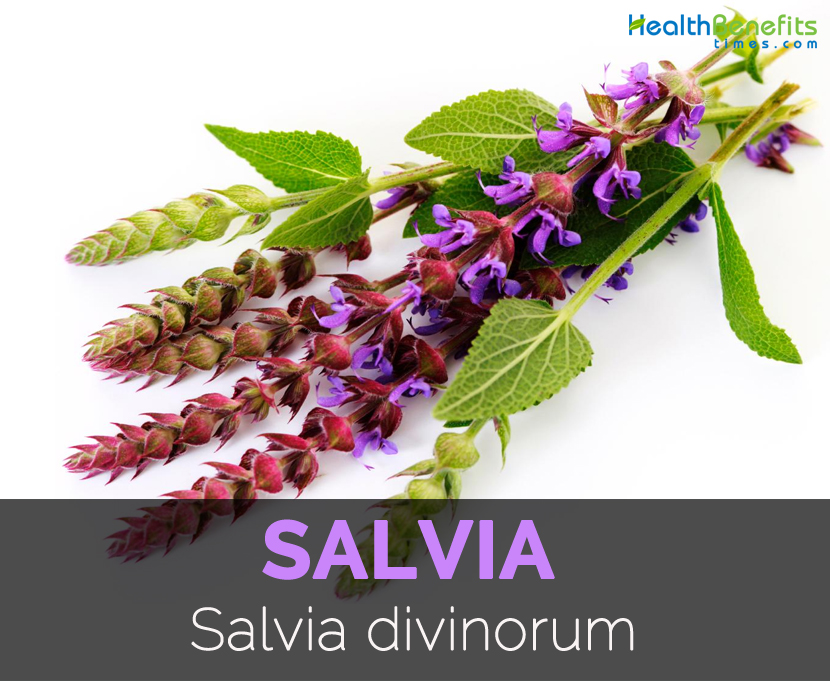| Salvia Quick Facts | |
|---|---|
| Name: | Salvia |
| Scientific Name: | Salvia divinorum |
The herb has been used in religious ceremonies by Mazatec Indians, a native people of Oaxaca, Mexico for centuries. They use it for ritual divination and healing. Mazatecs use the plant for conditions such as headache. Salvinorin A is an active constituent of Salvia divinorum.
Plant description
The species is annual, biennial or perennial herb with woody subshrubs. Typically the stems are angled like other members of family Lamiaceae. Generally, the leaves are entire but toothed or pinnately divided. Flowering stems have small bracts which is dissimilar to basal leaves. The bracts in some species are showy and ornamental. Flowers form in racemes or panicles which displays the color of flowers ranging from blue to red with white and yellow less common. Normally, the calyx is tubular or bell shaped without bearded throats and is divided into two parts or lips. An upper lip is entire or three toothed and lower two is cleft. Corollas are two lipped and claw shaped. Usually an upper lip is entire and three toothed. Lower lip has two lobes. Stamens are lowered to two short structures with anthers two celled. Flower styles are two cleft. Fruits are smooth, ovoid or oblong nutlets and also mucilaginous coating.
History
Native to Sierra Mazateca in Oaxaca, Mexico, it is still used by Mazatec that facilitates shamanic visions in context of curing as well as divination. It is one of the several species having hallucinogenic properties which are ritually used by Mazatec shamans. Shamans uses fresh leaves of S. ddivinorum. They consider the plant as incarnation of Virgin Mary and begin the ritual with invocation to Mary, the Holy Trinity, Saint Peter and other saints. In a quiet place, after ingestion of leaf, they say “La Maria (S. divinorum) speaks with a quiet voice.”
Also used for the purpose for treating health ailments such as anemia, diarrhea, rheumatism, headaches and semi-magical disease called panzon de Borrego or swollen belly.
Health Benefits of Salvia
1. Menstruation
Salvia helps to ease premenstrual syndrome by lowering pain, headache, swelling etc. It also effectively reduces severity of symptoms associated with menopause. The essential oil extracted from the plant offers estrogenic activity.
2. Lowers inflammation
Salvia plant has anti-inflammatory and antimicrobial properties. A cup of salvia tea per day helps to lower abdominal inflammation lowers the chances of urinary tract infection and also treats gingivitis.
3. Treat depression
The tea is helpful in improving emotional state. Antioxidants such as apigenin, diosmetin and luteolin reduce the symptoms associated with depression.
5. Improve memory
Study conducted at the University of Oxford concluded that Salvia extract promotes cognitive abilities. Cholinesterase, an enzyme that regulates catalyzation of hydrolysis of acetylcholine, is responsible for improving memory. The decline in this neurotransmitter is related with less cognitive ability.
5. Salvia and Antioxidant Benefits
Excess free radical activity and reduced antioxidant defenses create a state of oxidative stress. Over time, oxidative stress can damage all body tissues, with the brain particularly susceptible. Oxidative stress has been implicated in many neurological disorders including Alzheimer’s disease and Parkinson’s disease. Oxidative stress is also elevated in many mental health disorders including major depressive disorder and attention-deficit hyperactivity disorder (ADHD). Moreover, animal models of induced oxidative stress have confirmed that it can adversely influence memory and learning performance.
Salvia plants and their individual constituents possess strong antioxidant activity. In an analysis of 10 Salvia species, it was confirmed that all species exhibited significant antioxidant activity as measured by oxygen radical absorbance capacity, radical scavenging capacity and total phenolic content. The extent of antioxidant activity varied across species and extraction methods used, the ethanolic extract of S. officinalis exhibited the highest activity
Uses
- Leaves are dried as well as smoked.
- Leaves are also brewed and ingested in the form of tea.
- The liquid extract is vaporized and inhaled.
Medicinal uses
- Tea prepared from leaves comforts headache, abdominal pain, stomachaches and various disorders.
- The plant is used by Palestinians of Israel also for indigestion, stomachache and treating heart disorders.
- It is used for treating ulcer pains and indigestion in Jordan.
- In Turkey, it is used for gall bladder and kidney stones and also to provide relief from coughs, colds and influenza.
- The plant is used to improve memory.
Side effects
- The common side effects could be cluster headache, dizziness, nausea, and concentration problem, lack of co-ordination, confusion, slurred speech, amnesia, decreased heart rate and chills. The additional effects are loss of memory, tiredness, flushing, spatio-temporal dislocation.
- People with pre-existing mental health condition should avoid it.
References:
https://www.itis.gov/servlet/SingleRpt/SingleRpt?search_topic=TSN&search_value=506025#null
http://www.sagewisdom.org/appel.pdf
Comments
comments
